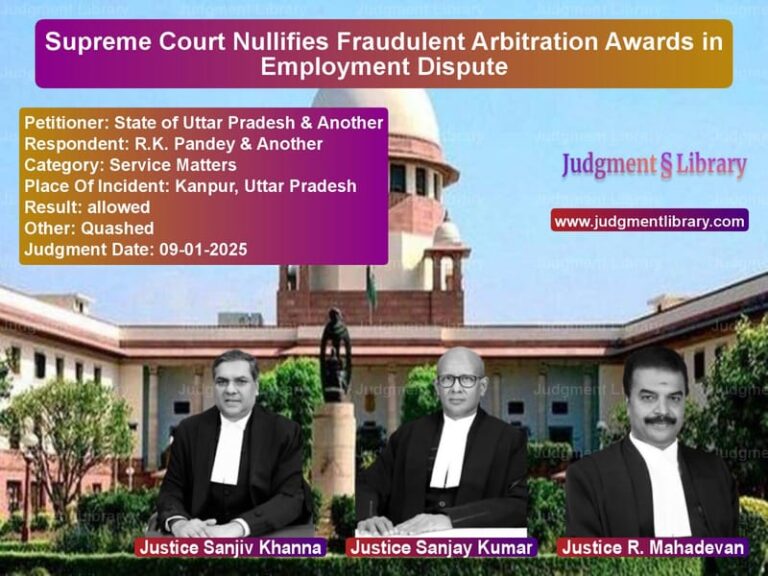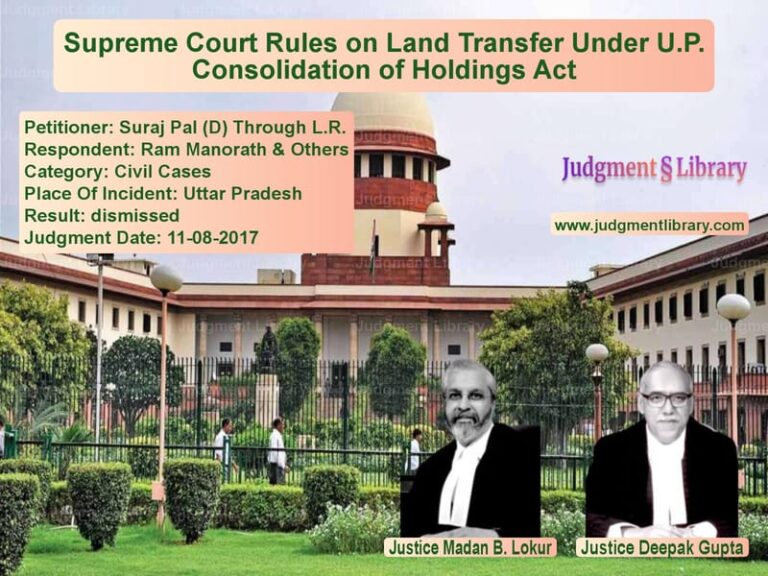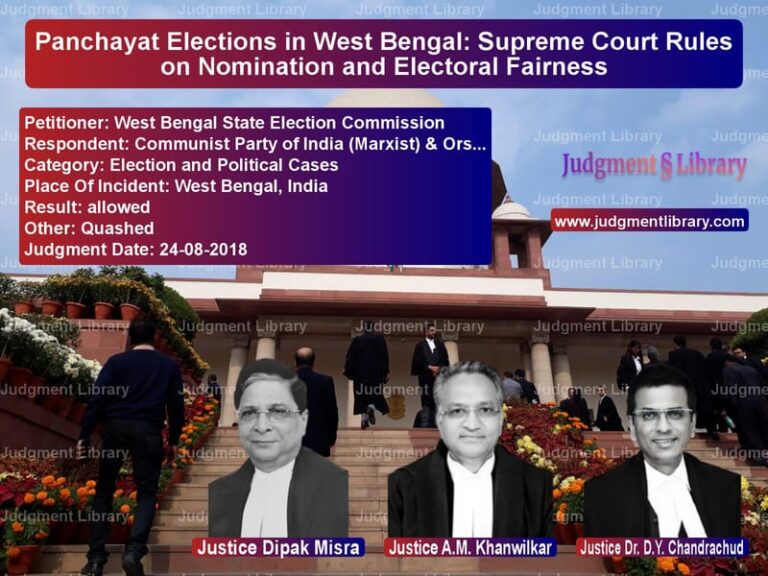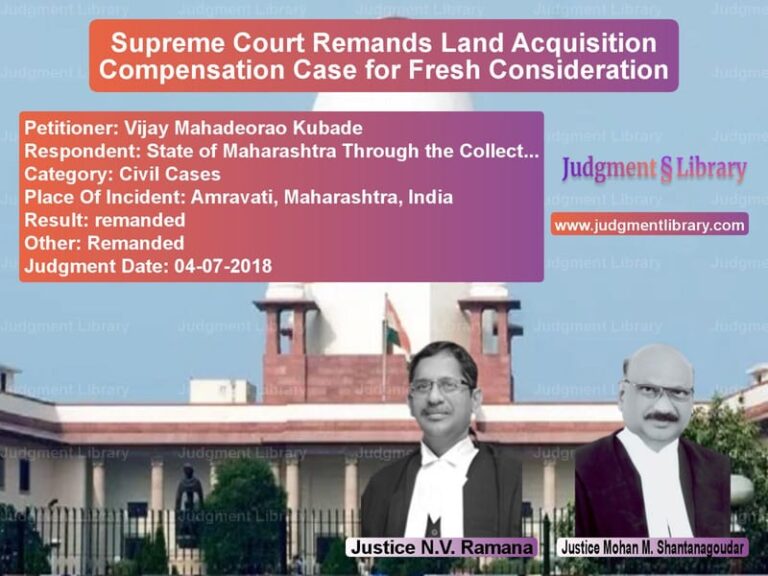Dowry Death or Murder? Supreme Court Acquits Accused Due to Lack of Conclusive Evidence
The case of State of Rajasthan vs. Ramanand is a crucial judgment that explores the boundaries between murder, dowry death, and abetment of suicide. The Supreme Court was called upon to determine whether the accused, Ramanand, had murdered his wife and daughter or whether there was insufficient evidence to hold him guilty beyond reasonable doubt.
The case revolved around the tragic deaths of Anita, the wife of the accused, and their minor daughter Ekta. The prosecution argued that the deaths were the result of strangulation followed by an attempt to burn the bodies to disguise the crime. However, the High Court ruled that the prosecution failed to prove beyond doubt that Ramanand was guilty of murder, reducing his conviction to abetment of suicide (Section 306 IPC). The Supreme Court, upon review, completely acquitted the accused, ruling that even abetment of suicide was not conclusively proven.
Background of the Case
The tragic incident took place on September 21, 2000, when Ramanand reported to the police that his wife and daughter had burned to death at their home in Patan, Rajasthan. The police initially treated it as an accident. However, Anita’s brother Rakesh Agrawal filed a complaint the next day, alleging dowry harassment and murder.
Key details of the incident:
- The accused claimed that he was at his shop when neighbors informed him of the fire at his home.
- Upon reaching the house, he found his wife and daughter dead due to severe burns.
- The deceased’s family alleged that Anita was subjected to dowry harassment and had been murdered.
- The forensic report suggested that the cause of death was strangulation and that the burns were post-mortem, indicating an attempt to cover up the crime.
Prosecution’s Case
The prosecution built its case on the following arguments:
- The post-mortem report confirmed that Anita and Ekta died due to strangulation and not burns.
- Burns were post-mortem, indicating a deliberate attempt to destroy evidence.
- There was a history of dowry harassment, as per the deceased’s family.
- The accused was the only adult present in the house at the time, and there were no signs of forced entry.
Defense’s Case
The defense argued that:
- The accused was at his shop when the incident occurred and was informed by neighbors.
- There was no direct evidence linking him to the crime.
- The prosecution failed to establish a clear motive.
- Family members of the deceased, including Anita’s parents, turned hostile and did not support the prosecution’s case.
Trial Court Judgment
The trial court convicted Ramanand under:
- Section 302 IPC (Murder) – Life imprisonment
- Section 201 IPC (Destruction of evidence) – Three years rigorous imprisonment
The court relied heavily on the forensic report and ruled that the accused had murdered his wife and daughter before attempting to destroy evidence by burning their bodies.
High Court Judgment
The accused appealed to the Rajasthan High Court, which overturned the murder conviction and reduced it to abetment of suicide (Section 306 IPC). The court found:
- There was no direct evidence of murder.
- The prosecution failed to prove that the accused was present at the scene when the deaths occurred.
- The motive for murder was unclear.
- The trial court’s reliance on circumstantial evidence was insufficient for a conviction under Section 302 IPC.
The High Court sentenced Ramanand to five years of rigorous imprisonment under Section 306 IPC.
Supreme Court Judgment
The State of Rajasthan challenged the High Court’s verdict before the Supreme Court, arguing that the accused should be convicted for murder based on the forensic findings.
The Supreme Court, comprising Justices Adarsh Kumar Goel and Uday Umesh Lalit, ruled in favor of Ramanand and acquitted him of all charges. The key findings were:
- There was no eyewitness testimony to establish that the accused committed the crime.
- Even though the post-mortem report indicated strangulation, there was no conclusive evidence linking Ramanand to the act.
- The prosecution failed to establish motive beyond reasonable doubt.
- The accused himself reported the deaths and was cooperative during the investigation.
- The statement made by Ramanand to the police (Ext. D-1) was not a confession and could not be used against him.
The Supreme Court concluded:
“The prosecution’s case rests purely on circumstantial evidence, and the circumstances on record do not rule out every other hypothesis except the guilt of the accused.”
On the issue of presumption of guilt, the Court stated:
“However strong the suspicion, an accused cannot be convicted unless the prosecution proves guilt beyond a reasonable doubt.”
As a result, the Supreme Court completely acquitted Ramanand, ruling that even the conviction under Section 306 IPC (abetment of suicide) was not justified.
Legal Precedents Considered
- Sharad Birdhichand Sarda vs. State of Maharashtra (1984) – Establishing that circumstantial evidence must form a complete chain.
- State of Punjab vs. Bhajan Singh (1975) – Holding that strong suspicion cannot replace proof beyond a reasonable doubt.
- Gambhir vs. State of Maharashtra (1982) – Reiterating the standard for circumstantial evidence in criminal cases.
Implications of the Judgment
- The ruling reinforces the principle that circumstantial evidence must be conclusive for a conviction.
- It highlights the judiciary’s role in preventing wrongful convictions based on suspicion.
- The judgment ensures that forensic reports, while important, must be corroborated by other evidence.
- The decision emphasizes that motive plays a crucial role in establishing criminal liability.
Conclusion
The Supreme Court’s ruling in State of Rajasthan vs. Ramanand is a landmark judgment on the importance of concrete evidence in murder cases. By overturning the conviction, the Court reaffirmed the principle that no person should be convicted unless guilt is proven beyond doubt. This decision serves as a precedent for ensuring that mere suspicion cannot lead to conviction in criminal trials.
Don’t miss out on the full details! Download the complete judgment in PDF format below and gain valuable insights instantly!
Download Judgment: State of Rajasthan vs Ramanand Supreme Court of India Judgment Dated 11-04-2017.pdf
Direct Downlaod Judgment: Direct downlaod this Judgment
See all petitions in Murder Cases
See all petitions in Domestic Violence
See all petitions in Custodial Deaths and Police Misconduct
See all petitions in Judgment by Adarsh Kumar Goel
See all petitions in Judgment by Uday Umesh Lalit
See all petitions in dismissed
See all petitions in supreme court of India judgments April 2017
See all petitions in 2017 judgments
See all posts in Criminal Cases Category
See all allowed petitions in Criminal Cases Category
See all Dismissed petitions in Criminal Cases Category
See all partially allowed petitions in Criminal Cases Category







